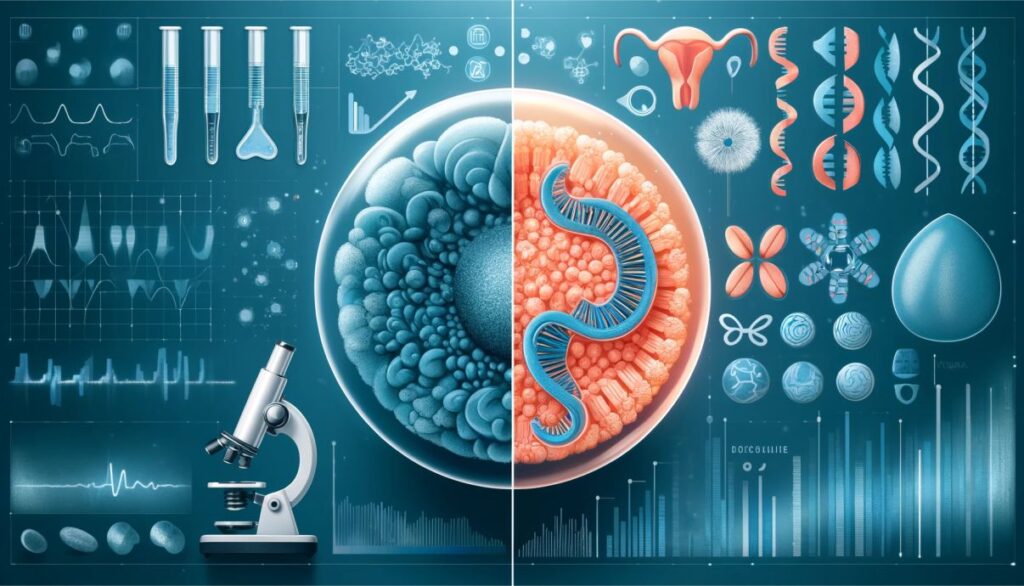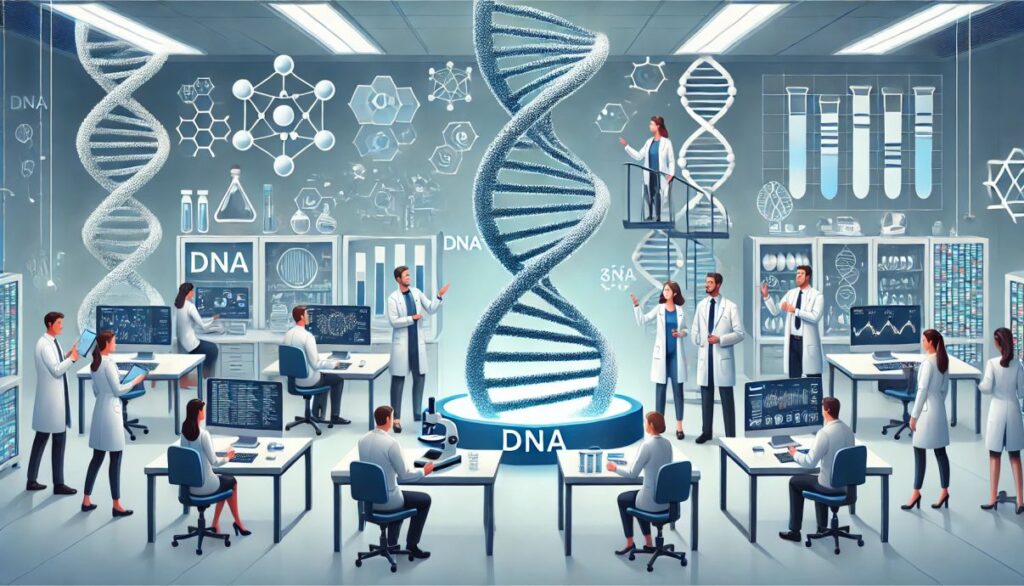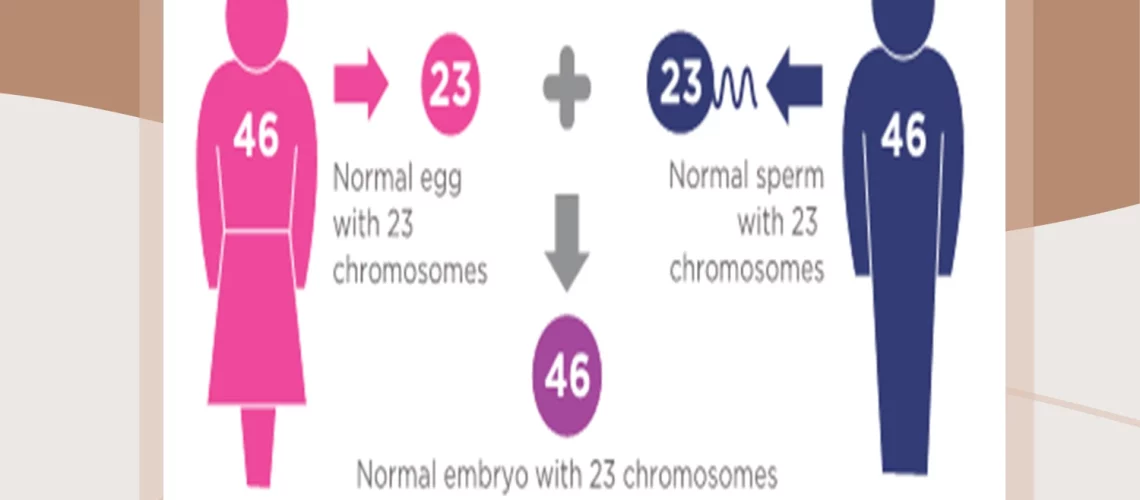整倍性和非整倍性 这些条件直接影响胚胎发育和遗传疾病的风险。 本文探讨了非整倍体和非整倍体的含义、它们在代孕过程中的意义,以及基因检测的进步如何帮助选择最可行的胚胎。
代孕中的非整倍体和非整倍体:确保胚胎存活
目录
切换什么是非整倍体和非整倍体?
非整倍体和非整倍体是遗传学中的重要概念,尤其与生殖健康和代孕相关。非整倍体是指存在一套完整的染色体,确保生物体正常发育。同时,非整倍体指染色体数目异常,可导致各种遗传疾病,如唐氏综合征和克氏综合征。
为什么非整倍体和非整倍体在代孕中很重要?
在代孕过程中,尤其是在试管婴儿等程序中,了解非整倍体和非整倍体是至关重要的,因为遗传因素会极大地影响怀孕的成功率。在妊娠代孕中,代孕者怀有通过辅助生殖技术产生的胚胎,选择染色体数目正确的非整倍体胚胎可以使妊娠结果更健康,并降低与遗传疾病相关的并发症发生的可能性。全面的医学评估对评估遗传风险至关重要,可确保意向父母获得成功的结果。
非整倍体和非整倍体如何影响胚胎发育?
非整倍体和非整倍体会严重影响胚胎发育,从而影响整体健康和存活率。当胚胎为非整倍体时,它们拥有正确数量的染色体,可进行正常的细胞分裂并形成健康的生物体。与此相反,非整倍体胚胎(无论是单体、三体还是其他染色体失衡导致的胚胎)可能面临发育障碍和挑战,从而导致植入失败或妊娠失败。
染色体完整性在胚胎发育中的作用怎么强调都不为过,因为优倍体胚胎通常更容易足月妊娠。适当染色体组的存在对于协调复杂的生物过程非常重要,例如:
- 细胞分化
- 器官的形成
- 荷尔蒙平衡
相比之下,表现出非整倍体的胚胎出现各种并发症的风险更高,包括
- 染色体疾病,如唐氏综合征(21 三体综合征)
- 增加流产的可能性
- 产后可能面临的长期健康挑战
了解这些影响突出了基因筛查在生殖健康中的重要性,有助于做出明智的决定,从而对妊娠结果产生重大影响。
代孕中染色体组不平衡的风险是什么?
染色体组不平衡(以非整倍体为特征)会给代孕带来重大风险,尤其会影响胚胎的健康和妊娠的结果。
染色体异常可导致各种遗传疾病,给胚胎和代孕者带来严重的并发症。例如,唐氏综合症等病症就是因为存在额外的 21 号染色体,从而导致独特的身体特征和发育迟缓。

同时,由于男性体内多了一条 X 染色体而导致的 Klinefelter 综合症会导致生育问题和潜在的学习障碍。患有非整倍体的胚胎流产的风险要高得多。
- 基因检测在及早发现风险方面发挥着关键作用。
- 这种检测不仅有助于选择健康的胚胎,还能让代孕者和意向父母为可能出现的结果做好准备。
归根结底,了解遗传因素及其影响加强了代孕过程中深思熟虑选择的重要性。
如何检测胚胎的非整倍体和非整倍体?
检测胚胎的非整倍体和非整倍体是辅助生殖过程(尤其是试管婴儿)中的一个重要步骤,因为它有助于确保选择可移植的胚胎。为此,胚胎植入前基因检测(PGT)得到了广泛应用,专家可以在胚胎移植前对胚胎的染色体组成进行评估。此外,无创产前检测(NIPT)可在妊娠早期进行,以进一步评估与胚胎相关的遗传风险,为意向父母及其代孕者提供有价值的信息。
植入前基因检测
胚胎植入前遗传学检测(PGT)是体外受精中的一项先进技术,用于在胚胎植入前筛查胚胎是否存在染色体异常。在植入前基因检测过程中,需要采取几个必要的步骤来筛选出最健康的胚胎。首先,从卵巢中取出卵子,在实验室中与精子受精,形成胚胎。一旦胚胎达到囊胚阶段,通常是受精后五天左右,就会从每个胚胎中仔细活检出几个细胞进行基因分析。分析的重点是
- 识别染色体异常,如非整倍体。
- 检测夫妻双方家族中可能存在的特定遗传疾病。
- 评估胚胎的整体质量对成功植入起着重要作用。
PGT 的好处是深远的。通过只选择最健康的胚胎进行移植,植入成功的可能性大大提高,而且还有助于将流产和后代遗传疾病的风险降至最低。因此,寻求不孕不育治疗的人可以增强信心,因为他们知道自己已经最大限度地提高了健康怀孕的机会。
无创产前检查
无创产前检测(NIPT)是一种现代方法,可在不造成任何伤害的情况下对胚胎的遗传物质进行评估。通过分析母体血液,该检测可在怀孕早期发现潜在的遗传风险并识别非整倍体,为准父母提供有关胚胎健康的重要信息。

这项创新技术为羊膜腔穿刺术和绒毛取样(CVS)等传统方法提供了一种非侵入性的替代方法,从而彻底改变了产前护理。
- 侵入性程序存在流产风险,而 NIPT 则不同,它具有显著的安全性。
- 这意味着父母可以获得有关婴儿健康的重要信息,而对并发症的担忧则降至最低。
NIPT 对某些疾病的检出率更高,大大提高了识别染色体异常(如唐氏综合症)的能力。通过提供这些早期信息,NIPT 使准父母有能力对自己的怀孕做出明智的决定,并为孩子的需要做好心理和情感准备。
随着基因检测技术的进步,NIPT 的相关性不断提高,巩固了其在现代产前诊断中的作用。
非整倍体和非整倍体知识如何帮助选择有活力的胚胎?
在选择可存活胚胎的过程中,了解非整倍体和非整倍体非常重要,因为这对成功妊娠的可能性有很大影响。通过先进的基因检测了解胚胎的基因组成,医疗服务提供者就能在知情的情况下决定植入哪些胚胎,从而解决不孕不育问题,提高成功怀孕的几率。
提高怀孕成功率
在试管婴儿手术中,选择优倍体胚胎可大大提高怀孕成功率,因为胚胎植入和健康发育的可能性更高。基因检测有助于鉴定可存活的胚胎,确保意向父母获得成功怀孕的最佳机会。
研究表明,与未选择的胚胎相比,植入前基因检测(PGT)可使活产率提高 30%。在一个著名的案例研究中,一家诊所证明,使用优倍体胚胎的成功率达到了惊人的 75%。
- 著名生殖内分泌专家简-史密斯博士强调,选择优倍体胚胎可降低流产风险。
- 研究表明,优倍胚胎有助于降低染色体异常率。
最近的一项荟萃分析证实了一个一致的模式,即选择胚胎选择的夫妇在整个试管婴儿过程中的满意度更高,情感和经济压力更小。 相关性显而易见:优先考虑优倍体胚胎不仅能提高受孕几率,还能提高努力成长的家庭的整体体验。
降低遗传疾病风险
通过选择非整倍体胚胎,可以大大降低唐氏综合症和克氏综合症等遗传疾病的风险,从而提高孩子的整体健康水平,并将妊娠失败的几率降至最低。了解非整倍体对胚胎选择的影响对准父母和代孕者都至关重要。
非整倍体是指染色体数目异常,可导致孕期各种并发症。例如,特纳综合征等以缺少一条 X 染色体为特征的疾病会导致发育障碍和其他健康问题。研究表明,选择非整倍体胚胎不仅能降低发生此类遗传疾病的可能性,还能促进孕期健康。
- 研究表明,如果优先考虑优倍体胚胎,成功的活产率会增加 30-50%。
- 医学专家强调植入前基因检测(PGT)对确保胚胎存活率的重要性。
造成非整倍体和非整倍体的原因是什么?
造成非整倍体和非整倍体的原因是多方面的,包括一系列影响遗传稳定性的因素。捐卵者或代孕者的年龄起着至关重要的作用,因为高龄产妇与染色体异常率增加有关。此外,环境因素和遗传基因也会对胚胎出现非整倍体或非整倍体的可能性产生重大影响。
捐卵者或代孕者的年龄
捐卵者或代孕者的年龄是影响胚胎非整倍体可能性的一个重要因素,因为高龄产妇的染色体异常发生率较高。这对包括试管婴儿和代孕在内的生育治疗有重要影响,因为较年轻的供卵者通常生产出的胚胎出现非整倍体的几率更大。
研究表明,35 岁以上的女性胚胎出现遗传疾病的风险明显增加,研究表明,40 岁时非整倍体率超过 50%。卵子质量的下降会导致流产和后代出现遗传疾病的风险增加。
- 根据《美国医学杂志》2018 年的一项研究 人类生殖在 43 岁及以上的捐献者的胚胎中,发现近 40% 为非整倍体。
- 相反,20-30 岁的捐献者异常率明显较低。
这些证据强调了从遗传健康的角度考虑孕产妇年龄的重要性,这不仅会影响捐卵者的选择,还会让候选人了解晚期妊娠的潜在风险。
环境因素
环境因素(如接触毒素、生活方式选择和营养习惯)可能会影响染色体的稳定性。要充分了解外部因素的影响,就必须认识到日常选择如何为胚胎发育创造更健康的环境。例如
- 接触家用清洁产品中的有害化学物质会扰乱内分泌功能,可能导致基因异常。
- 不良的饮食习惯,如过量的糖和加工食品,与较低的生殖健康结果有关。
- 缺乏有规律的体育锻炼不仅会影响整体健康,还会影响荷尔蒙平衡,进一步影响胚胎存活率。
以下是一些改进建议:
- 选择有机农产品,以减少农药接触。
- 经常参加体育活动,如散步、瑜伽或骑自行车。
- 采用富含维生素、矿物质和健康脂肪的均衡饮食。
通过这些调整,可以提高获得健壮、基因稳定的胚胎的几率。
基因遗传
基因遗传在发生非整倍体和非整倍体的过程中起着重要作用,因为特定的遗传条件会世代相传。染色体异常会严重影响生育结果,与非整倍体胚胎相比,整倍体胚胎成功植入的几率通常更高。
例如,由于 21 号染色体多了一个拷贝而导致的唐氏综合症等疾病,往往会因母亲的年龄而产生,这凸显了遗传背景的重要性。特纳综合征等疾病是由 X 染色体完全或部分缺失引起的,这也说明了遗传因素是如何导致染色体变异的。
- 遗传性疾病举例
- 先天愚型
- 特纳综合征
- 爱德华综合征
卵子或胚胎捐赠
卵子或胚胎捐赠为面临不孕不育挑战的个人提供了一个可行的选择,使试管婴儿等辅助生殖技术能够成功怀孕。捐献者提供遗传物质,使有意成为父母的人能够实现建立家庭的目标,同时还能应对代孕安排所需的复杂法律合同和医疗评估。
如何估计胚胎的遗传状态?
如果医生确定父母属于高危人群,将建议他们进行植入前基因检测。这意味着他们的胚胎将被活检,其中的一小部分(5-10 个细胞)将被带到基因实验室,经过调查,医生将收到:哪些胚胎是非整倍体,哪些是公共的,因此可以推荐转让。为了获得最佳的怀孕机会,在形态上质量最高,同时,将挑选整倍体胚胎进行移植。
非整倍体一定会导致孩子生病吗?
根据 植入前遗传学诊断 根据国际学会的建议,在没有非整倍体胚胎可供选择的情况下,移植非整倍体胚胎有一个 "优先 "清单。 这种优先权始于可能会导致健康问题的特定非整倍体。不过,需要进行更详细的孕期检查,通过超声波检查和生化筛查来估计所有的健康风险。不过,这将由您的医生进行估计,Pons 医学研究中心将为您寻找合适的专家进行会诊,以备不时之需。
基因检测代孕
代孕与基因检测相结合提供了一种提高成功怀孕几率的有效方法,因为意向父母可以通过植入前基因检测等先进程序选择没有染色体异常的胚胎。将基因评估与代孕相结合,可确保代孕者和胚胎的健康状况达到最佳,从而降低与不孕和妊娠失败相关的风险。
常见问题
什么是非整倍体,为什么它在代孕过程中很重要?
非整倍体是指胚胎中有一套完整的染色体,这对胚胎的健康发育至关重要。在代孕过程中,了解非整倍体有助于选择可行的胚胎,增加成功怀孕的机会。
什么是非整倍体,它对代孕有什么影响?
非整倍体是指胚胎中染色体数目不平衡,可能导致遗传疾病。
关于非整倍体和非整倍体的知识如何帮助选择可存活的胚胎?
通过了解非整倍体和非整倍体,可以识别胚胎中染色体数量的异常。这有助于在代孕中选择最健康的胚胎进行移植,增加成功怀孕的机会。
在代孕过程中,有关非整倍体和非整倍体的知识会给意向父母带来哪些益处?
透彻了解非整倍体和非整倍体可以帮助意向父母在代孕过程中就移植哪些胚胎做出明智的决定。这可以增加成功怀孕和生下健康宝宝的机会。
代孕中的非整倍体和非整倍体是否有潜在风险?
代孕中的超整倍体和非整倍体都有潜在风险。重要的是要咨询医疗专业人士,以了解风险并做出明智的决定。
在人工生殖技术中获得优质胚胎非常重要,因为这是治疗成功的关键。但“质量好”究竟意味着什么?这是关于胚胎学家对胚胎的显微镜评估吗?让我们回到这个问题的基础。
在受精过程中,来自父母双方的两个细胞会融合,父亲的精子和母亲的卵母细胞。每个细胞都储存着正常数量一半的染色体,而染色体是人体所有细胞中遗传物质的载体。但是当受精发生时,它们的基因组,每条基因组来自 23 条染色体(22 条常染色体和一条性染色体),将形成未来胚胎的基因组。
在正常情况下,在此过程下,胚胎将形成 46 条染色体:44 条常染色体,男女均等,以及两条性染色体:XX 代表女孩,XY 代表男孩。这种状态被称为“整倍体”,它意味着染色体的正常数量。
有时,根据父母的个体情况,他们的配子可能含有错误数量的染色体。原因可能与年龄有关,也可能与遗传问题、有害环境(电离辐射、某些药物)等医疗状况有关。
这将导致胚胎的形成,其染色体数目错误(少于 46 条或多于 46 条)。这称为“非整倍体”,可能会导致儿童出现健康问题。此外,此类胚胎在形态上可能是正常的,因此,在显微镜下,胚胎学家不会发现任何异常。胚胎的遗传状态不一定会导致其外观发生某些变化。

